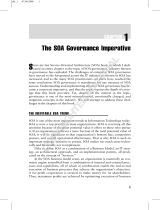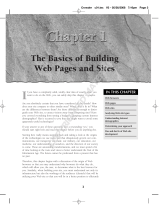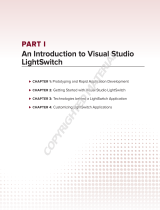Page is loading ...

1
Introduction
This book offers a practical guide to you if you want to improve the
return your organisation gets from its IT investments and
ultimately if you want to use IT to help drive transformation in your
organisation. The book distils what we have learned from
conversations with practitioners into six common-sense,
actionable principles, based on best practices, which you can use
to improve alignment between IT and business priorities, goals
and strategies.
This book is focused on improving the situation as it stands today.
It is not a collection of impractical theories or a set of best
practices from a single organisation, which cannot be broadly
applied. Throughout, it incorporates a wide variety of examples,
covering both where things have worked well and where they have
failed, from which you can draw based on your situation.
COPYRIGHTED MATERIAL

What on earth has IT got to do with gardening?
If everything in IT was working even mostly as it should be, this book would not be
necessary.
As things stand, it is.
IT doesn’t matter?
When former Harvard Business Review editor Nicholas Carr posited ‘IT Doesn’t Matter’
in 2003, he was making the point that component technologies are commoditising and
thus available to all. It‘s true that, for established companies (as opposed to ‘green fields’
such as Google, say), the acquisition of IT confers less in the way of strategic advantage
than it used to. It is not like the old days, when you could steal a march on your
competition as did, for example, American Airlines with its Sabre reservation system or
Dell with its online ordering and fulfilment systems.
However, there is another side to IT, concerning how it can actually prevent organisations
from progressing. In many organisations, IT is a bottleneck: it reinforces clunky processes,
complicates interpersonal communications and restricts business activities. IT and busi-
ness activity can be misaligned to such an extent that organisations are forced into
bankruptcy. This leads to the question, if IT isn’t actually helping the business, what
the heck is it there for?
Where we fundamentally agree with Carr is that IT shouldn’t matter quite so much, in the
first instance – given the promise of technology, the fact that it is a bottleneck is a travesty.
Many organisations would be delighted if IT became no more than an efficiently run,
commoditised platform, since it would be a vast improvement over the hotchpotch of
inefficient, legacy technologies they are forced to put up with. And even relatively young
companies can quickly find themselves hampered by past technology investments.
Ironically, commoditisation can make things worse, since the same underlying trends that
render the strategic business value of core technology marginal illustrate even more
starkly the weaknesses in how technology is deployed. Like castles built on sand, new
technologies are layered on top of the rather shaky foundation of the old, increasing
complexity in the hope that old problems will be resolved, or perhaps concealed by the
new. Although the ‘what’ of IT might be a commodity, the ‘how’ of IT – and specifically
‘how’ it is employed in the support of business initiatives and functions – absolutely does
matter. As the utilisation of technology within organisations becomes more and more
complicated, the focus needs to move away from the ‘what’ and towards the ‘how’.
This is as true for public organisations as it is for private companies. Public bodies
differentiate themselves on the basis of the services they deliver to their constituencies:
should they fail, they can be reorganised into oblivion. More and more public agencies must
2 Introduction

operate in the same way as commercial businesses: indeed, there are a number of examples
in this book of how it is in their best interests to look for commercial opportunities. But
first, of course, they need to get on top of their costs and use IT to support the existing
services, without which commercial potential is no more than that, potential.
We need to treat the ecosystem
The killer is that although individual technologies might not matter, business value is
both realised through and constrained by the orchestrated operation of the whole
ecosystems of technologies and service providers. The goal of this book, therefore, is
twofold. First, it sets out to help you reduce the waste, minimise the problems and achieve
a state of improved business alignment – that is, where your IT capability matches up with
your business needs. In other words, it shifts IT from being a bottleneck to being a
foundation, as shown in the first two steps of Figure 1.1.
Having done this, it is then possible to determine how IT can make a real difference to the
business (the final step in Fig. 1.1), above and beyond the competition – IT as a differ-
entiator. We’re not looking to turn everyone into Google. Rather, we believe that organisa-
tions have the opportunity to improve above and beyond what is considered the norm.
Only once you have escaped from the primeval swamp of legacy IT, are you in a position to
use it to your advantage – and in this, you have as much chance of success as anybody else.
Our research – both gained as a result of a collective 80 years in the IT industry and
specifically conducted for this book – strongly suggests that the knowledge, tactics and
strategies that comprise the ‘how’ are far from commodities. There are pockets of best
practices, but there are vast expanses of corporate space where the relationships between
Making everything “just work”
Making a real difference to business
IT as bottleneck
IT as foundation
IT as
differentiator
Figure 1.1: IT transformation
What on earth has IT got to do with gardening? 3

IT investments and their business environments are highly dysfunctional. Often, this is as
much a result of business organisation dysfunction as IT dysfunction: to succeed, both
must be treated at once.
Entering the technology garden
There’s something about a garden. Stand in the middle of one and it will tell you a story,
about its purpose and intentions, its current state and perhaps most importantly, who
looks after it. One thing that will be immediately apparent – so obvious; in fact, it almost
goes without saying – is that it will be different from one day to the next.
A garden is not fixed in time. There are too many influences, too many factors – from the
weather to invasions of parasites – that can change and impact its state. Not only are its
individual components in a constant state of growth – or, indeed, death – but each
component can also impact everything else, so a leafy tree in summer prevents things from
growing beneath it, or a climbing plant, left unkempt, quickly overcomes its neighbours.
Also, seasonal effects stimulate their own cycles of new growth, as plants, trees and shrubs
blossom, cross-pollinate and go back into wintry hibernation. Every day, sun and rain
cause change – living in Britain we are only too aware how unpredictable the weather can
be and the unexpected effects it can have.
We know all of this to such an extent, in fact, that we accept it without question and deal
with the consequences: prune before the spring; don’t plant in the shade; keep on top of
the weeds. Everything from soil to sap is dealt with as part of the whole, as all must
function together.
Technology components are not plants: we have not yet invented self-building robots or
self-modifying code. However, it is the gardening state of mind that is so lacking in today’s
IT organisations. As mentioned in the preface, there is a tendency to persist with the idea
that technology, once implemented, should just work – even though we know it is a false
premise. Instead, there is an urgent need to adopt a very different model for how IT
capabilities are defined, deployed and managed.
In this book, we focus a great deal on the idea of ‘services’.Toexplainwhattheseare,
consider how many times you have heard someone exclaim, ‘Idon’tknowwhythey
makethesemobilephonessocomplicated,allIwanttodoismakephonecalls!’ While
a phone may be technologically complex, that is no excuse to lose sight of its primary
purpose – to enable voice calls. That is the difference between technology and service.
While technology components may be fixed, services most certainly are not. They, like
plants, are dependent on context, can grow and diminish in importance as the ‘seasons’ of
a business change from investment, to growth or consolidation. Services can restrict each
4 Introduction

other’s capabilities. And, like plants, services have a lifecycle. They are created, developed,
maintained, and ultimately, they die, but the garden as a whole is sustainable, if it is
tended correctly.
Above all, that is where the ‘garden’ paradigm makes the most sense. In our research for
this book, we have learned a great deal about how organisations successfully achieve and
sustain alignment between IT and the business. If sustainability is the goal, it is services
that must be cultivated, whatever the underlying technology foundation.
So, look around your organisation. Do you consider your IT capabilities in terms of
services? Do you understand their purpose and their current state and what is expected of
them? Most of all, what do they tell you about who looks after them? If all you see is an
overgrown mess, all is not lost – even the most chaotic gardens can be rescued from chaos
and returned to their former glory, or indeed, made comparable to the best.
The technology garden provides organisations large and small with the opportunity to get
on top of IT and to make it work for them. As we are naturally inclined to be positive
about the potential of IT, we see the portfolios of existing and potential investments that
crowd every corner of today’s organisations, as plots of unworked land. A lot of people
would rather not think too hard about the bacteria, worms and the organisms that
populate those plots (Answer: hundreds of bacteria and up to a million fungi in every
gram, as well as hundreds of worms, millipedes and other bugs!). To us, every organi-
sation’s IT environment is a hectare of uneven soil. But soil is an amazing thing. If
appropriately planted, and with the right amount of water and sunlight and attention,
amazing things can happen.
Aligning IT and the business
What does it mean to ‘align IT and business’? What does it mean to ‘add value to business’
through IT? Indeed, what kind of ‘value’ are we talking about?
In practice, today there are three key focuses where businesses look to IT to deliver value:
Improving operational business efficiency and effectiveness
Managing risk and compliance
Supporting innovation.
All these focuses actually place different emphases on ‘value creation’, but they all bring
the same challenges – not least the need to effectively balance investment for the right mix
of short-term and long-term paybacks. In reality, a business wants to drive towards all
three of these things, and IT needs to be able to support all three in ways that fit with the
mission in hand.
Aligning IT and the business 5

It’sdifficult to define an idea as broad as IT–business alignment succinctly, but a working
definition should go something like this:
IT-business alignment is a collaborative process that businesspeople and IT
organisations go through to create an environment in which investment in IT and
delivery of IT services reflect business priorities, whether IT services are sourced
internally or externally; and in which business priorities are influenced by
understanding of IT capabilities and limitations.
Aspects of IT–business alignment
The definition used above aims to highlight that there are three core aspects to IT–
business alignment that must all be considered if things are to improve. The three aspects
are three high-level phases of an overall IT lifecycle: investment, service delivery and
change management.
Figure 1.2 shows these three aspects. First, let’s look at the importance of considering IT
investment. This reflects the fact that IT is now integral to the way that businesses operate.
Historically, IT has been viewed by the business as somewhat of a ‘black art’, best left to IT
practitioners, with the result that investment in IT has been treated as a special case. With
IT now playing such a critical role, this position is no longer tenable. Investment in IT
must be subject to the same priorities which govern investment in other assets – people,
facilities, production lines, among others – on which the continued operation of the
business depends.
IT
Business
Change
implications
Change
capabilities,
limitations
Investment
Service
delivery
Figure 1.2: The elements of IT–business alignment
6 Introduction

Second is the delivery aspect. This is a direct consequence of the first aspect. It highlights
that the way in which the IT delivery organisation provides services to the business must
be governed by the same business priorities. This extends to encompass the way that IT
service delivery is measured. Only then will it be possible for businesspeople to assess the
business return on their investment in IT.
Finally, with IT now so integral to the way that business operates, it is no longer feasible
for business decisions to be taken without a clear understanding of the IT implications of
those decisions. Business leaders and the IT delivery organisation must participate as
peers in the business change management process and adopt a systematic approach to
assessing the IT implications of any change. Such collaboration puts the IT organisation
in a position where it can actually influence business change by highlighting the challenges
and opportunities arising from technology change.
The principles of IT-business alignment
In our research, interviews and discussions, a number of core principles have emerged
that are critical to bringing IT and business closer together. Before we list them, here’sa
serious caveat: to really make the most of IT in business, it’s important to realise that both
have to bend. Like two people locked in a small box, for an IT organisation and its
business ‘customer’ to get comfortable, they both have to coordinate their actions so that
neither gets an eye gouged or a foot stuck in an awkward place. Business and IT are
intimately intertwined.
Either you decide to embrace the role of IT in business or you decide to ignore the
possibilities and accept current state of compromise. If you’re prepared to step up to the
plate and take advantage of the benefits that modern IT and IT practices can bring to your
organisation, you will have to be prepared for some discomfort. Recognise, however, that
doing nothing and consigning your organisation to mediocrity is still a decision – unless,
of course, you are already doing everything right – in which case we shall come to see you
personally to present the champagne.
For the vast majority of organisations that wish to align their IT closer with the business,
we believe there are a number of principles which, applied in the right way, will offer
significant benefits over just sitting on hands and hoping some bright spark will take the
problem away. We’ve condensed the findings of our research into six principles, and the
later chapters will look at each one in more detail. These are as follows:
The IT organisation must get the basics right: without the fundamentals of sound IT
service delivery, it will be impossible to build the appropriate level of trust with the
business.
Create a common language: a shared understanding of goals, strategies, activities,
metrics and change implications is a crucial foundation for the delivery of effective IT
Aligning IT and the business 7

capabilities. A common language is essential for the establishment and maintenance of
that shared understanding.
Establish a peer relationship between business and IT: there needs to be real sharing
of authority and responsibility when it comes to making and implementing decisions
that have implications for business and IT.
Work towards coordinated goals and objectives: a common language is not enough if
ever-broadening communities of IT stakeholders are to be led in a way that promotes
agreement on what’s important and what isn’t. IT–business alignment needs a culture
that promotes working together in a coordinated way to meet shared goals and
objectives.
Manage IT as a business-driven portfolio: effective management of IT investments
requires a big-picture view that does not just consider work that is planned or in
progress, but also fully encompasses past investments to ensure a net overall contribution
of value to the business from IT spending. This view needs to balance risks, costs and
returns across the business as a whole.
Foster relationships with key IT suppliers: effective supplier management is essential,
because suppliers provide IT capabilities and are potentially an invaluable source of
skills, resources and insights to help optimise the delivery and support of services to
the business. More than that, though, a lack of supplier management can lead to
higher costs, unnecessary risks and failure to maximise return on IT investments.
While these principles can be applied in isolation, there are many synergies and depen-
dencies between them. If the IT organisation cannot establish business trust by getting the
basics right, for example, then it becomes very difficult for IT to establish a peer relation-
ship with the business. Similarly, coordinated goals and objectives can only be worked
towards if there is a common language between business and IT.
A word about Enterprise Architecture
On a specific point, given that the central theme of this book is the alignment of IT
activities with the business, and that this alignment must take place at all levels, it is
worthwhile emphasising a thread that runs throughout our discussion that provides an
important frame of reference.
You will find us using the term ‘Enterprise Architecture’ (EA) quite frequently, which is
relatively common in IT industry parlance but can mean different things to different
people. In the context of this book, we use EA to refer to that all-important framework for
IT–business alignment.
At the highest level, EA is based on a mapping of organisational, process and IT structures
and dependencies, and how these may need to change in the future to achieve business
8 Introduction

goals and objectives. We’ll be discussing different perspectives on EA in context as we
explore the various aspects of alignment activity, and particularly how the concept may be
applied incrementally without running into ‘analysis paralysis’ and other problems which
so often plague enterprise mapping and modelling exercises that attempt to ‘boil the
ocean’. So look out for references to EA as we go, as it is a crucial element in the overall
equation.
Finding your way around this book
What does this book contain?
The book consists of four sections: a summary of where we are today and how we got here,
the principles themselves, their application in a real-world environment and scorecards,
as follows.
The current realities of business and IT
This section contains a brief overview of the history of IT and how things stand now: a
complex interwoven network of business and IT challenges. The central question it poses
is, given the 50 years of innovation we have seen, why is IT still not delivering business
value? It then sets out the imperatives on IT–business alignment, defining what needs to
be done to solve such challenges and to provide a firm foundation for future growth.
The principles
These sections describe the principles themselves. Each of the principles follows the same
format:
Common areas of misalignment: documents the issues faced by organisations today, to
illustrate the need for the principle.
Alignment imperatives: brieflydefines where organisations need to get to and what that
would look like.
Achieving alignment: describes the core transformational advice and guidance and
highlights the key actions to achieve alignment.
Maintaining alignment: explains how to sustain alignment and prevent things drifting
out of alignment over time.
Summary: summarises the key challenges and actions.
For each principle, we explain the different stakeholders involved, their roles and their
expectations. We also provide practical examples to show how the principles have been
Finding your way around this book 9

applied in the real world. The book does not shy away from investigating the tensions
between the business and the IT department, as this understanding is key to overcoming
the alignment impasse.
Applying the principles
This section maps out a path towards sustainable IT–business alignment, based on a series
of four alignment goals – gain trust from the business, understand the business, engage
the business and drive the business – through which the principles can be applied in a
practical manner. It explains the role of Enterprise Architecture and outlines an agile
approach to IT–business alignment to facilitate incremental application of the principles.
Scorecards
This section presents some practical checklists and questions to enable you to determine
where you are in terms of the principles and their application. These are provided to help
the business and the IT organisation gauge where they are along the evolutionary path
towards alignment. Subsequently, the scorecards can be used as a basis for reviews and
audits.
Who is it for?
This book provides practical guidance to business and IT professionals in technical and
management roles in organisations that can benefit from improved IT–business align-
ment. While these organisations will tend to the larger (mainly because smaller companies
can generally work around the challenges described here), we do not believe that the size
of the organisation is the deciding factor; rather, it is dictated by the answers to such
questions as
Is IT currently constraining your organisation – are there business situations in which
IT is a bottleneck?
Is there a disconnect between how IT is deployed and operated, and what the business
is trying to achieve?
Has the potential of technology to be a differentiator thus far proved to be an elusive
goal?
If this is the case, this book is for you. Its mission is to provide principles that any
organisation can follow, at least in part, to derive tangible and direct benefit from their
current and future IT investments.
We wrote this book to provide a common point of reference for IT and businesspeople. As
such, it is written in plain English and does not descend into technical detail – though
10 Introduction

some terminology may be unfamiliar, it is clearly defined and explained. As such, the book
provides a common vocabulary for both sides, to break through the mystique and jargon,
and to lower the communication barriers between technical and nontechnical stake-
holders.
Finally, the book is aimed at any other party with an interest in IT–business alignment,
not least the IT supplier community. It explains how technology vendors, integrators and
service providers should present their offerings to potential customers in a way that can
maximise the chances of success.
Finding your way around this book 11

/










